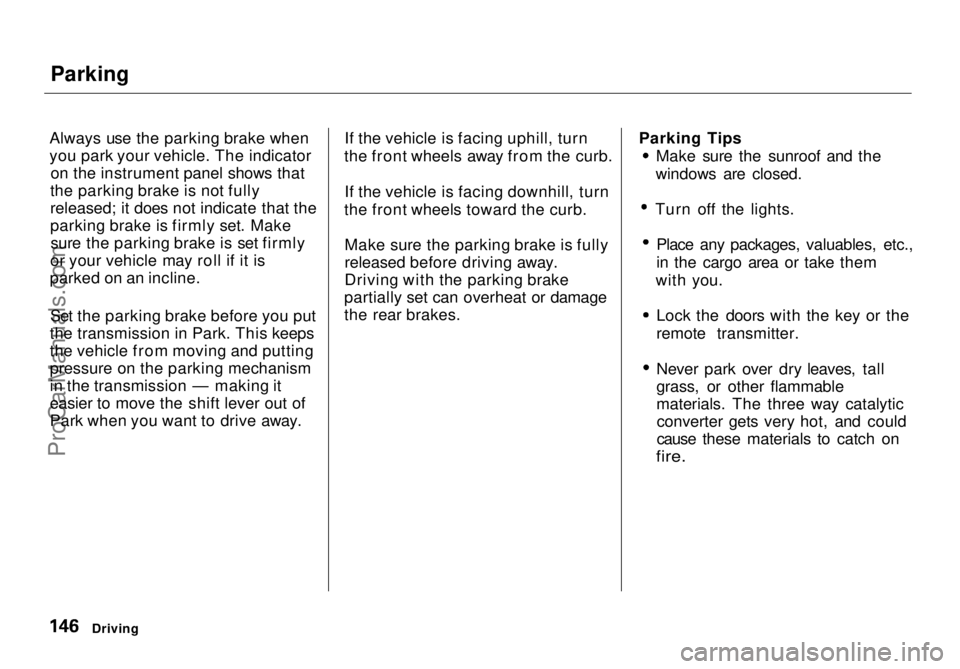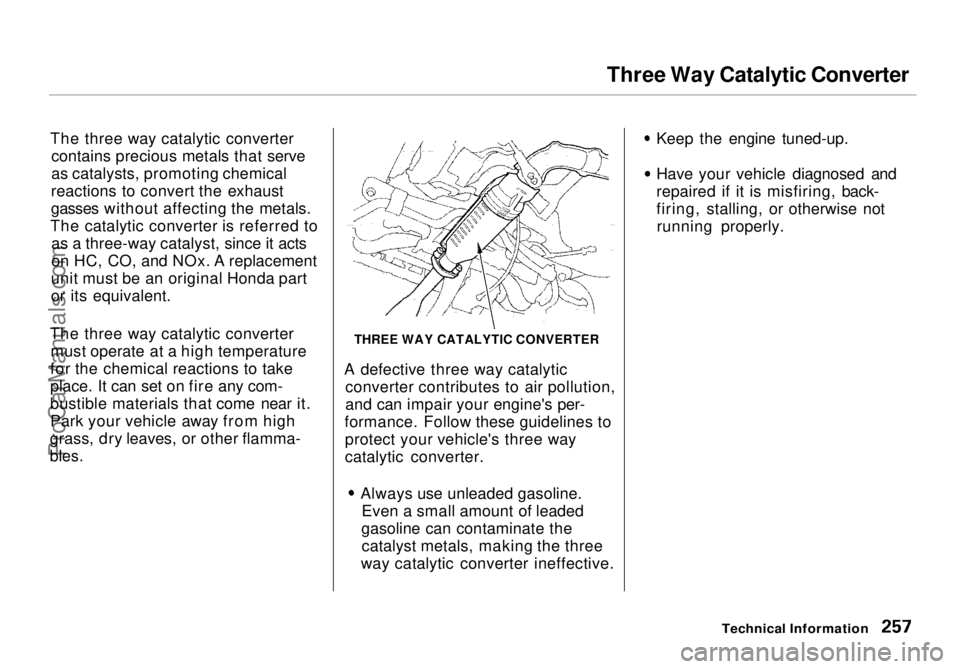1998 HONDA ODYSSEY catalytic converter
[x] Cancel search: catalytic converterPage 146 of 272

Parking
Always use the parking brake when
you park your vehicle. The indicator on the instrument panel shows that
the parking brake is not fully
released; it does not indicate that the
parking brake is firmly set. Make sure the parking brake is set firmly
or your vehicle may roll if it is
parked on an incline.
Set the parking brake before you put
the transmission in Park. This keeps
the vehicle from moving and putting
pressure on the parking mechanism
in the transmission — making it
easier to move the shift lever out of
Park when you want to drive away. If the vehicle is facing uphill, turn
the front wheels away from the curb.
If the vehicle is facing downhill, turn
the front wheels toward the curb.
Make sure the parking brake is fully
released before driving away.
Driving with the parking brake
partially set can overheat or damage
the rear brakes. Parking Tips Make sure the sunroof and the
windows are closed. Turn off the lights.
Place any packages, valuables, etc.,
in the cargo area or take them
with you. Lock the doors with the key or the
remote transmitter.
Never park over dry leaves, tall
grass, or other flammable
materials. The three way catalytic
converter gets very hot, and could
cause these materials to catch on
fire.
DrivingProCarManuals.comMain Menu Table of Contents s t
Page 242 of 272

Technical Information
The diagrams in this section give
you the dimensions and capacities of
your Honda, and the locations of the identification numbers. The expla-
nations of several electronic and
mechanical systems on your Hondaare for the more technically-oriented
owner. Identification Numbers................. 246
Specifications................................. 248
Tire Information............................ 250 Tire Size Designation................ 250
Wheel Size Designation............ 250
Tire Speed Ratings.................... 250
Tire Pressure Adjustment For High Speed Driving........ 251
DOT Tire Quality Grading....... 251 Treadwear.............................. 251
Traction.................................. 252
Temperature.......................... 252 Oxygenated Fuels.......................... 253
Driving in Foreign Countries....... 254
Emissions Controls........................ 255 The Clean Air Act...................... 255
Crankcase Emissions Control System..................................... 255
Evaporative Emissions Control System..................................... 255
Exhaust Emissions Controls.... 256 PGM-FI System..................... 256
Ignition Timing Control
System................................. 256
Exhaust Gas Recirculation (EGR) System.................... 256
Three Way Catalytic Converter............................ 256
Replacement Parts..................... 256
Three Way Catalytic Converter... 257
Technical InformationProCarManuals.comMain Menu s t
Page 251 of 272

Driving in Foreign Countries
If you are planning to take your
Honda outside the U.S. or Canada,
contact the tourist bureaus in the
areas you will be traveling in to find out about the availability of unleaded
gasoline with the proper octane
rating.
If unleaded gasoline is not available,
be aware that using leaded gasoline
in your Honda will affect perfor-
mance and fuel mileage, and damage
its emissions controls. It will no
longer comply with U.S. and Canadian emissions regulations, and
will be illegal to operate in North
America. To bring your vehicle back into compliance will require the re-
placement of several components, such as the oxygen sensors and the
three way catalytic converter. These
replacements are not covered under
warranty.
Technical InformationProCarManuals.comMain Menu Table of Contents s t
Page 253 of 272

Emissions Controls
Exhaust Emissions Controls
The exhaust emissions controls include four systems: PGM-FI,
Ignition Timing Control, Exhaust
Gas Recirculation and Three Way
Catalytic Converter. These four
systems work together to control the
engine's combustion and minimize
the amount of HC, CO, and NOx that comes out the tailpipe. The exhaust
emissions control systems are
separate from the crankcase and
evaporative emissions control
systems.
PGM-FI System
The PGM-FI System uses sequential multiport fuel injection.
It has three subsystems: Air Intake,
Engine Control, and Fuel Control.
The Powertrain Control Module (PCM) uses various sensors to
determine how much air is going
into the engine. It then controls how
much fuel to inject under all operat-
ing conditions. Ignition Timing Control System
This system constantly adjusts the ignition timing, reducing the amountof HC, CO and NOx produced.
Exhaust Gas Recirculation (EGR)
System
The Exhaust Gas Recirculation (EGR) system takes some of the
exhaust gas and routes it back into
the intake manifold. Adding exhaust
gas to the air/fuel mixture reduces
the amount of NOx produced when
the fuel is burned.
Three Way Catalytic Converter
The three way catalytic converter is in the exhaust system. Through
chemical reactions, it converts HC,CO, and NOx in the engine's exhaust
to carbon dioxide (CO2), dinitrogen
(N2), and water vapor.
Replacement Parts
The emissions control systems are designed and certified to work to-
gether in reducing emissions to
levels that comply with the Clean Air
Act. To make sure the emissions remain low, you should use only newGenuine Honda replacement parts or
their equivalent for repairs. Using
lower quality parts may increase the emissions from your vehicle.
The emissions control systems are covered by warranties separate from
the rest of your vehicle. Read your
warranty manual for more informa-
tion.
Technical InformationProCarManuals.comMain Menu Table of Contents s t
Page 254 of 272

Three Way Catalytic Converter
The three way catalytic converter contains precious metals that serve
as catalysts, promoting chemical
reactions to convert the exhaust
gasses without affecting the metals.
The catalytic converter is referred to as a three-way catalyst, since it acts
on HC, CO, and NOx. A replacement
unit must be an original Honda part
or its equivalent.
The three way catalytic converter must operate at a high temperature
for the chemical reactions to take
place. It can set on fire any com-
bustible materials that come near it.
Park your vehicle away from high
grass, dry leaves, or other flamma-
bles.
A defective three way catalytic
converter contributes to air pollution,
and can impair your engine's per-
formance. Follow these guidelines to protect your vehicle's three way
catalytic converter.
Always use unleaded gasoline.Even a small amount of leaded
gasoline can contaminate the catalyst metals, making the three
way catalytic converter ineffective. Keep the engine tuned-up.
Have your vehicle diagnosed and
repaired if it is misfiring, back-
firing, stalling, or otherwise not
running properly.
Technical Information
THREE WAY CATALYTIC CONVERTERProCarManuals.comMain Menu Table of Contents s t
Page 270 of 272

Index
Storing Your Car............................ 211
Sunroof.............................................. 83 Closing Manually....................... 238
Operation...................................... 83
Supplemental Restraint System Servicing....................................... 46
SRS Indicator.......................... 45, 52
System Components.................... 44
Synthetic Oil................................... 174
Tailgate............................................. 72
Taillights, Changing Bulbs in....... 208
Taking Care of the Unexpected.. 221
Tape Player............................ 107, 119
Technical Descriptions Drivin
g in Foreign Countries... 254
Emission Control Systems........ 255
Oxygenated Fuels...................... 253
Three Way Catalytic Converter................................ 257
Tire Information........................ 250
Temperature Gauge........................ 56
Tether Attachment Points.............. 38
Three Way Catalytic Converter... 257 Time, Setting the............................. 86
Timing Belt..................................... 195
Tire Chains..................................... 201 Tire, How to Change a Flat.......... 223
Tires................................................ 196 Air Pressure............................... 196Checking Wear.......................... 198
Compact Spare........................... 222
DOT Tire Quality Grading....... 251 Inflation....................................... 196
Inspection................................... 198
Replacing.................................... 199
Rotating....................................... 199 Snow............................................ 201
Specifications............................. 249
Transmission Checking Fluid Level................ 182
Fluid Selection............................ 182
Identification Number............... 246
Shifting the Automatic.............. 142
Treadwear...................................... 251
Trip Meter........................................ 55
Turn Signals..................................... 59
Tools, Tire Changing.................... 223
Towing
ATrailer......................................152
Emergency Wrecker................. 244
Vanity Mirror................................... 88
Vehicle Capacity Load .................. 137
Vehicle Dimensions....................... 248
Vehicle Identification Number..... 246
Vehicle Storage.............................. 211
Ventilation......................................... 96
VIN..................................................246
Vinyl Cleaning................................ 216
Viscosity, Oil................................... 174
Underside, Cleaning...................... 218
Unexpected, Taking Care
of the........................................... 221
Uniform Tire Quality Grading..... 251
Unleaded Gasoline......................... 128
Upholstery Cleaning...................... 216
Used Oil, How to Dispose of........ 156ProCarManuals.comMain Menu s t